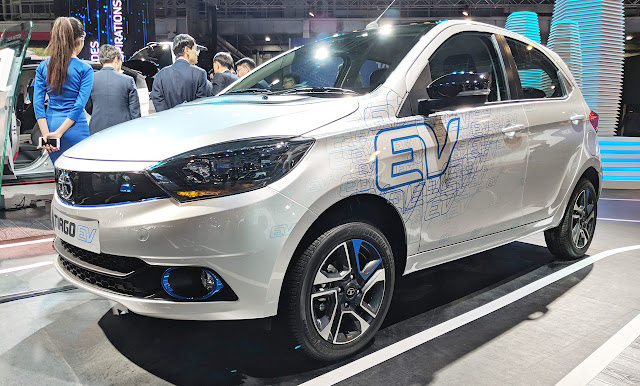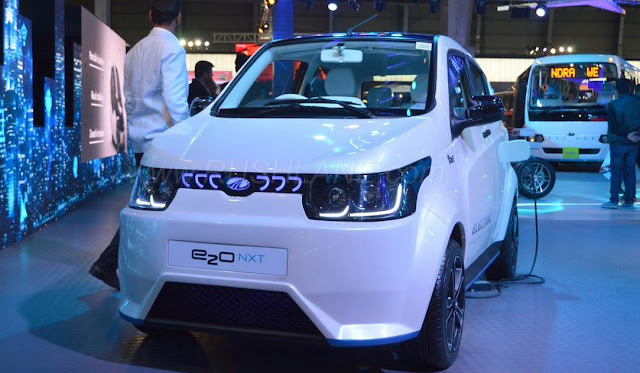The Government of India is fully dedicated to make India a 100% EV nation by 2030 that led to a sharp rise in stock of companies with an exposure to EVs. Electric vehicles (Cars, Buses) will be the future of our country because very soon the running cost of the vehicle could be around 20 to 30 paise per km and can attain the speed of 40-50 km per hour. Its cost will be so much less that People will soon shift from petrol/diesel vehicles to electric vehicles. The Most important thing is that the Electric Vehicles could create $300 Billion Domestic Battery Market by 2030.One more thing you have to notice is that the government had launched the FAME India scheme in 2015 offering incentives on electric and hybrid vehicles of up to Rs 29,000 for bikes and Rs 1.38 lakhs for cars. So if you want 30-40% compound annual growth rate (CAGR) you have to consider this sector and you must add electric Vehicles stocks into your portfolio. This has prompted all the leading automobile manufactures to think about e mobility. Let’s have a look at the electric vehicles showcased by the auto makers in the 2018 Delhi Auto expo.
Tata Motors:
Tigor EV & Tiago EV
Tata Motors has showcased the Tigor EV at the Auto Expo 2018. This is not the first time that the Tigor EV has showed its face in public though, because Tata has already started delivering the EV to the government-run EESL in order to fulfill the tender it bagged last year. Visually both the Tiago and the Tigor EV look similar to their standard hatchback and subcompact sedan version. However, both see the addition of blue decals and of course an EV badging on the front grille.
The Tiago & Tigor EV is a full electric, zero emission cars set to build on the existing Passenger Vehicles portfolio of Tata Motors. Equipped with a single speed, automatic transmission, both the cars will allow the customers to enjoy the seamless acceleration. The prices are unknown but they won't come cheap and we expect it to be between ₹ 8 to 10 lakhs.
Tata unveils its hyped sportscar RaceMo in an electric avatar. The car is christened Tata RaceMo +- and it offers a range of 350 kms after a single full charge. Tata RaceMo was unveiled for the first time at 2017 Geneva Motor Show but that was a petrol engine powered model. The Tata RaceMo’s engine is mounted on the rear and the two-door sportscar is the first such vehicle to be made by the company. Tata RaceMo has been designed in the company's design studio in Italy. The Tata RaceMo +- electric showcased at Auto Expo 2018 offers a total range of 350 kms per single full charge. Besides, there is also an option of fast charging with the help of which the customer can get a decent range after a few hours of charging. All this is thanks to an electric motor that produces 200 hp of power and it comes linked to a lithium ion battery pack.
Mahindra:
e-KUV100 NXT
e-KUV100 NXT is the electric version of the KUV 100. Except for the EV badging at the rear, the electric KUV100 looks similar to the regular car. The interiors too are shared with the regular KUV 100. Mahindra says the electric KUV is connected as well so it’s packed with Smartphone connectivity, remote diagnostics feature, cabin pre-cooling, real time location tracking and even keeps an eye on the driving patterns of the drivers with battery status. It has a range of about 140km on a single charge.
Mahindra has launched the updated version of their e20NXT electric car at the 2018 Delhi Auto Expo. The e2o facelift looks more premium and gets bull-horn LED elements in the headlight along with funkier alloy wheels. The four-door setup ought to remain the same, while on the inside, it is going to receive a bigger, tablet-like touch screen infotainment system with all the connectivity features like Bluetooth, AUX-in and USB placed bang in the middle. As evident from the size chart the new model will be bigger than the existing model, but that might not translate into more space inside the cabin as the wheelbase remains exactly the same.
Along with the e-KUV and e20NXT facelift Mahindra showcased two new EV concepts named Udo and Atom. Udo is a two seater mobility pod while Atom is an ‘urban mobility concept for smart India’. Udo has been conceived to battle the traffic congestion and pollution in urban environments. The mobility pod caters to tech savvy urban citizens and offers an enclosed cabin with micro lighting, climate control, touch screen infotainment system, and Bluetooth audio system. he most interesting feature of the Udo is the Smart Fitness system which allows the users to work on their cardio while commuting! Yes, you can do so by making use of the concept’s smart cycling feature. The tadpole construction ensures that the driver doesn’t need to use his/her foot to balance the vehicle when it’s standing still.
The Atom aims to re-imagine the last mile connectivity solution for India’s upcoming smart cities, thereby transforming the way public transportation works in the country. The minimalist design is claimed to have achieved a compact footprint while maximizing interior space. Atom’s electric power train is powered by a battery pack which can be swapped quickly to ensure uninterrupted service round the clock. The on board connectivity system is designed to make seamless bookings and payments. The system also provides real time updates on next train, bus or flights, and nearest boarding points. The Mahindra Atom concept also offers several convenient and safety features.
Suzuki :
eSurvivor concept
Suzuki e-Survivor Concept was unveiled at the 2017 Tokyo Motor Show and now it comes to India at the Auto Expo 2018.It's a quirky SUV ,it comes with four in-wheel electric motors but it's been envisioned as a two-seater car without a roof, but what we can see is that it's a 4x4. The e-Survivor comes with electrically retractable running boards and features a modern front fascia derived from the Jimny with circular LED headlights and an illuminated five-slot grille. The cabin is just as interesting as the design of the car as you get a massive full-width head-up display along with a screen built into the flat-bottomed steering wheel. The centre console sees the use of yet another display that gives out a wide array of information in a 3D layout.
Hyundai :
Ioniq EV
The Korean carmaker has brought the Ioniq EV to the Auto Expo 2018, the Ioniq looks more concept car than production model, and you do see the very latest of Hyundai’s styling cues on it. The Hyundai Ioniq has a distinctive design with a five-door setup. The front comprises of a sleek hexagonal grille which blends with the Bi-xenon/LED headlights along with vertically stacked LED Daytime running lamps (DRLs) incorporated in the bumper. A swooping C-pillar and the two-tone eco-spoke alloy wheels stand out at the sides. The Ioniq Electric packs a large 28kWh battery for up to 280km of emission-free driving. The motor makes 120PS of power and 295Nm of torque. The gearbox in it is a single-speed reducer transmission which helps the car clock a top speed of 165kmph.
Honda:
Sports EV Concept
Honda Sports EV, which was first unveiled at the 45th Tokyo Motor Show, features an old-school sports car design with modern technology. Based on a new platform built specifically for electric vehicles, the Sports EV gets a low and wide stance that lends it an aggressive look. The car features two black panels at the front and rear that also incorporate the headlamps and tail lamps. This black panel is actually a screen that can display messages to other drivers or show the charge status. The Sports EV Concept gets the ‘Honda Automated Network Assistant’ that is capable of monitoring the driver’s emotional well-being and make new choices and recommendations. It can even recommend music based on the mood among various other functions. Honda has not revealed the power train details of the Sports EV.
Renault:
Zoe e-Sport
Renault showcased its performance-focused Zoe e-Sport at the motor show it is a more powerful iteration of the Zoe electric hatchback. Drawing inspiration from Renault’s Formula E involvement, the Zoe e-Sport is powered by two electric motors that produce a combined 466hp and 640Nm of peak torque; its claimed 0- 100kph time is a rapid 3.2sec. The standard Zoe is powered by a new 41kWh battery, up from the 22kWh unit that was used in the previous model. It has a driving range of up to 400km (under the European driving cycle) and takes 65min for an 80 percent charge via a quick charger. Renault claims a real-world driving range of 300km and also a full-charge time of 8-9 hours using a standard 7kW charger.
Renault Trezor concept is an all-electric sports coupe that also happens to be an autonomous car. The Trezor is designed keeping human intricacies in mind and has a lot of hexagonal elements both inside and outside the cabin. The highlight though, is the canopy style single door that opens to reveal the full body underneath it. The Trezor concept derives most of its technology from the Renault’s Edams FIA Formula E racecar, which is the fully electric racecar having a top speed of 215 kmph. The interiors have an ultra HD touch screen display panels throughout. Powering the Trezor is an electric motor which develops 350PS of power and 380Nm of torque. The motor draws power from two different battery packs located separately - one at the front and other at the rear. Each battery has its own cooling system optimized by variable-geometry air intake incorporated in the bonnet. The Trezor also features a brake-operated energy recovery system. Renault claims the Trezor can accelerate from 0-100kmph in less than four seconds.
Kia:
Soul EV
Kia Soul EV is a five-door crossover; the Soul EV is styled typical of the breed, making it look like a hatchback on stilts. Design-wise, the Soul EV is decidedly polarizing with a boxy-looking silhouette and rounded bits at the corners. While it is underpinned by the same platform as the larger Ceed hatchback, the Soul EV shares very little with the hatchback under the hood. A 27kW lithium-ion battery (with fast-charging capability) powers the front wheels, sending 110hp and 285Nm of peak torque. Kia claims a range of 190km on a single charge, a 0-96kph time of 10.8sec and a top speed of 145kph.
On the inside, the all-electric crossover features OLED digital instrumentation and an 8.0-inch centrally mounted touch screen infotainment system (which doubles as a reversing camera) that comes with EV monitoring software, satellite navigation, DAB radio, and USB and Bluetooth connectivity. Other equipment offered on the Soul EV includes dual-zone climate control, electrically heated and folding door mirrors, keyless start and entry, heated front seats and steering wheel, parking sensors and cruise control.







































